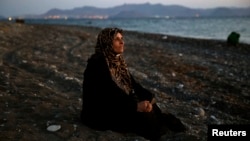When war photographer Graeme Robertson met a boy in Uganda whose skin looked as if it was falling off his face, he was shocked to discover the boy had been attacked for being blind.
"Sometimes when you have a blind child they will try and kill them, set them on fire, lock them in a hut for the rest of their life, forget about them," Robertson said, speaking from his home in London.
It is unclear who carries out the attacks, but it is likely to be relatives or members of the community acting under pressure from community elders, he said.
"I was angry that people thought that just because they were disabled, they weren't worth anything," he said. "I felt I could help. I knew that they were so badly mutilated, they would make powerful images, and if somebody saw these images they would feel something."
Robertson, an award-winning photographer who works for the London-based Guardian newspaper, approached an international charity for the blind, Sightsavers, and together they organized a photography exhibition highlighting the issue.
The exhibition, based on trips to Uganda and India, opened for the second time in London on Aug. 25.
Over the past 20 years, Robertson has covered wars and famines and spent years living in Baghdad and Afghanistan.
"It's not like I'm not used to seeing real human suffering, but this particular project really affected me," he said.
Robertson, who is badly dyslexic, was treated very differently from other children at school and told he would never succeed.
"Everybody should be given at least a chance. I felt these disabled people were not even given the opportunity to succeed," said the father of two young children.
"This one girl I photographed ... she was really badly treated in the community - raped, beaten up, horrific stuff. I couldn't believe this was happening."
Robertson said communities lack understanding about disability, money for equipment and access to specialist schools.
Children able to attend a specialist school blossomed under the encouragement and attention they received, he said.
There are an estimated one billion people with disabilities, about 80 percent of whom live in developing countries, according to Sightsavers.
They were left out of a 15-year international push, which expires this year, to improve living standards in developing countries, including access to health and education, and a reduction in poverty, the charity said.
Uganda has achieved free universal education, but nearly half of all children with disabilities are out of school because of the lack of equipment and staff needed to support them, according to Sightsavers.
"This means that over the 15 years, the lives of people with disabilities have got worse," Natasha Kennedy, policy campaigns manager at Sightsavers, said.
Disability has now been included in a new series of development targets to be agreed by global leaders at a U.N. summit in September, known as the Sustainable Development Goals.
People with disabilities are included in all the targets, including universal access to education and healthcare, and ending poverty.
"It's huge because it means that for the first time ... governments and donors must include people with disability as a principle of global development and not as an afterthought," Kennedy said.
Although the cost of including people with disabilities in targets such as education and healthcare is significant, the cost of leaving them out is even greater, she said.
"These people want to be contributing, out there working, learning, socialising and having fulfilling lives and the only way they can do that is if the systems include them from the very outset," Kennedy said. "You can't realistically eliminate poverty unless you're reaching the most vulnerable and most marginalized - and they are people with disabilities," she added.
Robertson's photo exhibition will travel to New York to coincide with the U.N. summit at the end of September.










